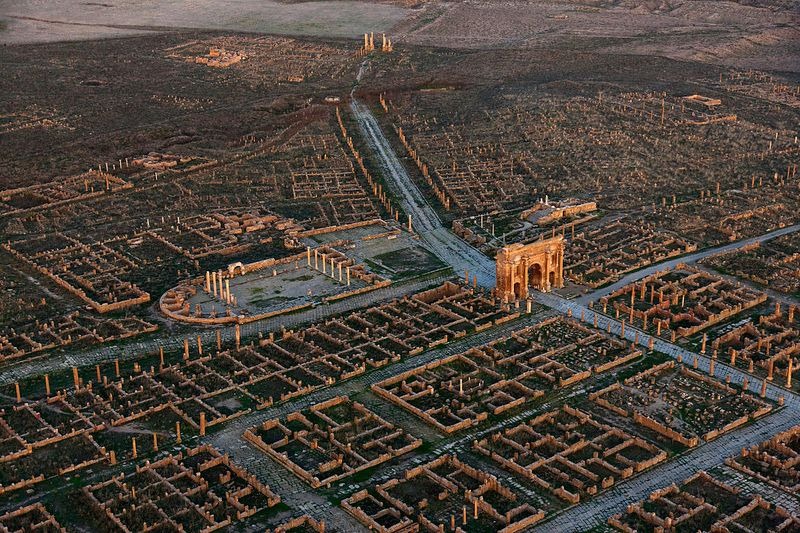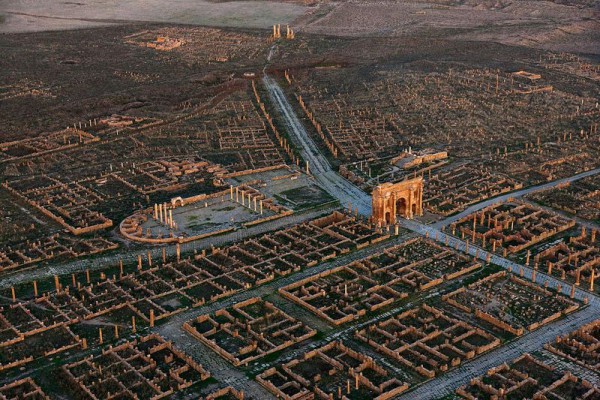The ancient city of Timgad is located to the north of the massif of the Aurès in a mountainous site of great beauty, 480 km south-east of Algiers and 110 km to the south of Constantine. It represents a remarkable example of a Roman military colony which was created ex nihilo.
Colonia Marciana Traiana Thamugadi was founded in 100 A.D. by emperor Trajan, as an encampment for the 3rd Augustan Legion and it was meant to serve as a defense position against the Berbers which were attacking from the Aures Mountains. The first residents of this colony were mostly Parthian veterans of the Roman army that received land as payment for their years of service.
Timgad follows the guidelines of Roman town planning, a remarkable grid system. It has an orthogonal street design based on the cardo (north–south-oriented street) and decumanus maximus (east-west-oriented street). It is a typical example of an urban model, a model which is still used today. This speaks a lot about Roman ingenuity. The basis of this building model is the military encampment, the predecessor of the city of Timgad.
By the sixth century C.E., Timgad was burned to the ground by local Arab tribes and eventually sank into oblivion for over 1,000 years.
Luckily, the dry desert air and sands have preserved the city in great condition.
Timgad has a temple dedicated to Jupiter, with similar dimensions as the Pantheon in Rome. There is a large Byzantine citadel standing to the southeast of the city. One of the highlights of the city is a 3,500-seat theater in good condition. There is also a library, a basilica, and four public bath houses.
At the west end of the decumanus maximus street there is 12-meters-high triumphal arch, called the Arch of Trajan, which is still standing today
Many major public buildings will arise in the new quarters of Timgad: Capitolium, temples, markets and baths
The plan of Timgad, laid out with great precision, illustrates the peak of Roman urban planning. By the middle of the 2nd century
Because no new settlements were founded on the site after the 7th century, the town was partially preserved under sand up to a depth of approximately one meter
The encroachment of the Sahara on the ruins was the principal reason why the town is so well preserved
After the Arab sacking in the 8th century the city disappeared from history until its excavation in 1881
The city was founded ex nihilo as a military colony by the emperor Trajan around AD 100
Originally designed for a population of around 15,000, the city quickly outgrew its original specifications and spilled beyond the orthogonal grid in a more loosely organized fashion
It was originally populated largely by Parthian veterans of the Roman army who were granted lands in return for years of service
The rapid growth of the city will expand it out of the limits of its original foundation
A 3,500-seat theater is in good condition and is used for contemporary productions. The other key buildings include fourthermae, a library, and a basilica.
Source: unesco, amusingplanet


![timgad-algeria-1[2]](https://www.thevintagenews.com/wp-content/uploads/sites/65/2015/10/timgad-algeria-12.jpg)
![timgad-algeria-2[2]](https://www.thevintagenews.com/wp-content/uploads/sites/65/2015/10/timgad-algeria-22.jpg)
![timgad-algeria-4[6]](https://www.thevintagenews.com/wp-content/uploads/sites/65/2015/10/timgad-algeria-46.jpg)
![timgad-algeria-5[6]](https://www.thevintagenews.com/wp-content/uploads/sites/65/2015/10/timgad-algeria-56.jpg)
![timgad-algeria-6[2]](https://www.thevintagenews.com/wp-content/uploads/sites/65/2015/10/timgad-algeria-62.jpg)
![timgad-algeria-7[6]](https://www.thevintagenews.com/wp-content/uploads/sites/65/2015/10/timgad-algeria-76.jpg)
![timgad-algeria-8[6]](https://www.thevintagenews.com/wp-content/uploads/sites/65/2015/10/timgad-algeria-86.jpg)
![timgad-algeria-9[6]](https://www.thevintagenews.com/wp-content/uploads/sites/65/2015/10/timgad-algeria-96.jpg)
![timgad-algeria-10[2]](https://www.thevintagenews.com/wp-content/uploads/sites/65/2015/10/timgad-algeria-102.jpg)
![timgad-algeria-11[2]](https://www.thevintagenews.com/wp-content/uploads/sites/65/2015/10/timgad-algeria-112.jpg)
![timgad-algeria-12[2]](https://www.thevintagenews.com/wp-content/uploads/sites/65/2015/10/timgad-algeria-122.jpg)